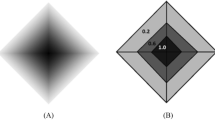Abstract
Current Geographic Information Systems (GISs) are inadequate for performing spatial analysis, since they force users to formulate their often vague requests by means of crisp selection conditions on spatial data. In fact, SQL extended to support spatial analysis is becoming the de facto standard for GISs; however, it does not allow the formulation of flexible queries. Based on these considerations, we propose the extension of SQL/Spatial in order to make it flexible. Flexibility is obtained by allowing the expression of linguistic predicates defining soft spatial and non-spatial selection conditions admitting degrees of satisfaction. Specifically, this paper proposes an extension of the basic SQL SELECT operator; proposes the definition of some spatial functions to compute gradual topological, distance, and directional properties of spatial objects; introduces a new operator for defining linguistic predicates over spatial properties, and reports the related formal semantics.
Preview
Unable to display preview. Download preview PDF.
Similar content being viewed by others
References
Bertino, E., Vantini, G.: Advanced Database Systems and Geographical Information Systems. In: Proc. of the II Workshop on AITSES, pp. 1–10 (1996)
Burrough, P.A., Frank, A.U. (eds.): Objects with Indeterminate Boundaries. GISDATA series. Taylor & Francis, Abington (1996)
Petry, F.E.: Fuzzy Databases. Kluwer Academic Pub., Dordrecht (1996)
Zadeh, L.A.: The concept of a linguistic variable and its application to approximate reasoning, parts I, II. Information Science 8, 199–249, 301–357 (1997)
Zadeh, L.A.: Fuzzy Sets as a Basis for a Theory of Possibility. Fuzzy Sets and Systems 1, 3–28 (1978)
Bosc, P., Prade, H.: An Introduction to the Fuzzy Set and Possibility Theory-based Treatment of Flexible Queries and Uncertain and Imprecise Databases. In: Motro, A., Smets, P. (eds.) Uncertainty Management in Information Systems: from Needs to Solutions, pp. 285–324. Kluwer Academic Pub, Dordrecht
Bosc, P., Buckles, B., Petry, F.E., Pivert, O.: Fuzzy Databases. In: Bezdek, J.C., Dubois, D., Prade, H. (eds.) Fuzzy sets in Approximate reasoning and information systems: the handbook of fuzzy set series, pp. 404–468. Kluwer Ac. Pub, Dordrecht (1999)
Bosc, P., Pivert, O.: SQLf: a relational database language for fuzzy querying. IEEE Trans. on Fuzzy Systems 3, 1–17 (1995)
Kacprzyk, J., Zadrosny, S.: FQUERY for ACCESS: fuzzy querying for Windows-based DBMS. In: Bosc, P., Kacprzyk, J. (eds.) Fuzziness in database management systems, pp. 415–433. Physica verlag (1995)
Egenhofer, J.: Spatial SQL: A Query and Presentation Language. IEEE Trans. on Knowledge and Data Engineering 6(1), 86–95 (1994)
Cary, N., Mak, M.: A survey on Query Languages for Content-based retrieval, ???
Huang, B., Lin, H.: Design of a Query Language for Accessing Spatial Analysis in Web Environment. Geoinformatica (2000)
OGC.OpenGIS-Simple Features Specification for SQL, http://www.opengis.org/techno/specs.htm (1998)
ArcView GIS, Using ArcView GIS, ESRI inc. (1999)
Cood, E.: A Relational Model for Large Shared Data Banks. Communications of the ACM 13, 377–387 (1970)
Erwig, M., Guting, R.H., Schneider, M., Vazirgiannis, M.: Spatio-Temporal Data Types: An approach to Modeling and Querying Moving Objects. Geoinformatica 3(3), 269–296 (1999)
Bordogna, G., Chiesa, S.: A Fuzzy Object-Based Data Model for Imperfect Spatial Information Integrating Exact Objects and Fields. Int. Journal of Uncertainty, Fuzziness and Knowledge- Based Systems 11(1), 23–41 (2003)
Author information
Authors and Affiliations
Editor information
Editors and Affiliations
Rights and permissions
Copyright information
© 2004 Springer-Verlag Berlin Heidelberg
About this paper
Cite this paper
Bordogna, G., Psaila, G. (2004). Fuzzy-Spatial SQL. In: Christiansen, H., Hacid, MS., Andreasen, T., Larsen, H.L. (eds) Flexible Query Answering Systems. FQAS 2004. Lecture Notes in Computer Science(), vol 3055. Springer, Berlin, Heidelberg. https://doi.org/10.1007/978-3-540-25957-2_25
Download citation
DOI: https://doi.org/10.1007/978-3-540-25957-2_25
Publisher Name: Springer, Berlin, Heidelberg
Print ISBN: 978-3-540-22160-9
Online ISBN: 978-3-540-25957-2
eBook Packages: Springer Book Archive




